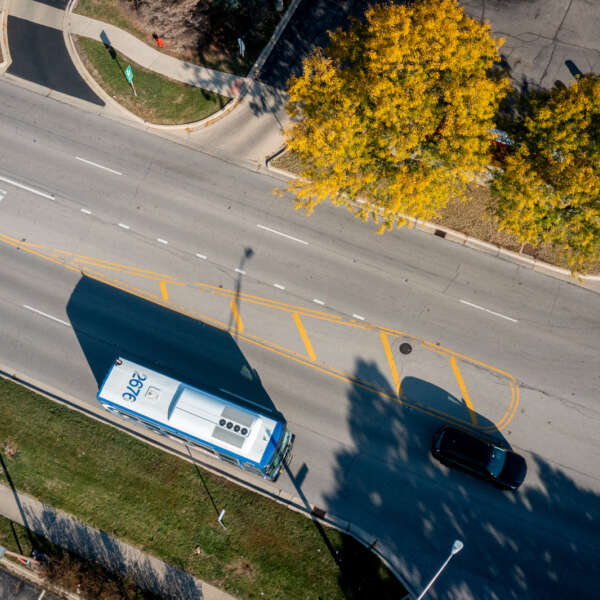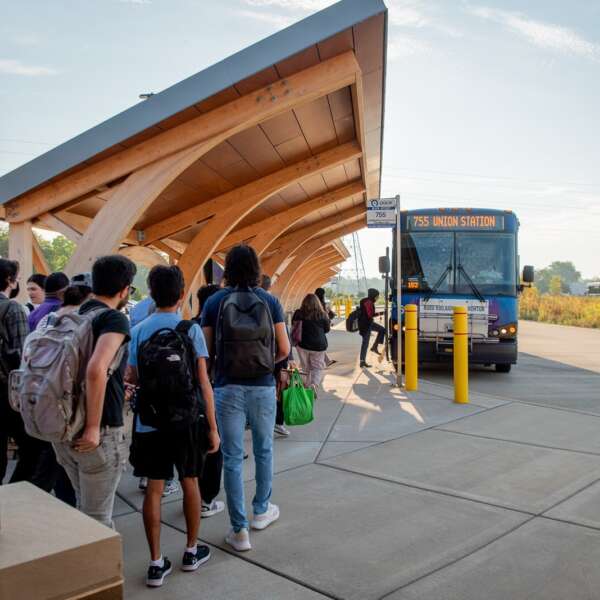RTA releases Transit-Friendly Communities Guide, hosts webinar on making transit accessible to more people throughout region
February 25, 2025
February 25, 2025

Last month, the RTA published its Transit-Friendly Communities Guide, a roadmap to creating equitable neighborhoods across the Chicago region that are safe and accessible to transit. This comprehensive resource provides local decision-makers, developers, and community advocates with strategies and tools to design thriving communities centered around transit. With a focus on improving accessibility, walkability, and sustainability, the guide is a direct implementation step of the RTA's strategic plan, Transit is the Answer.
Learn about the Transit-Friendly Communities Guide and how you or your local leaders can use it to improve transit access in your community by registering for the RTA’s webinar taking place at noon on Tuesday, March 4. The session will feature a presentation of the guide followed by a panel discussion featuring Chicago-area planners who have successfully applied the guide’s best practices to foster equitable transit-oriented development (ETOD) in their communities.
Attendees will learn how to use the guide to create transit-friendly communities, including design concepts, accessible infrastructure, transportation and land use policies, and strategies for equitably engaging community members. There will be an opportunity for audience questions during the panel discussion. Learn more and register now.
For communities interested in support for transit-related plans, the RTA’s Community Planning Program offers funding, technical assistance, and resources to help municipalities create and adopt transit-oriented development strategies. If you’re seeking additional support to implement transit-friendly development in your community, mark your calendar for the next Community Planning call for projects, which opens March 10. Visit www.rtachicago.org/cp for more information when the call opens.
The Transit-Friendly Communities Guide came out of Transit is the Answer, which called for “a transit-friendly communities policy to set standards for communities that host transit services to support and encourage land-use decisions that improve access to transit to ensure that our riders can travel safely and efficiently.” It is an update to a similar guide created in 2012; the new guide reflects changes in mobility and land use development markets, such as a new focus on equitable TOD, new micromobility options like bike and scooter share, housing availability and affordability challenges, etc.
The main goal of the guide was to support, encourage, and educate decision makers on ways to make their communities more transit-friendly, as well as to identify barriers and opportunities (and strategies) to transit-friendly development.
The Transit-Friendly Communities Guide contains a variety of research and strategies for improving a community’s access to transit. The guide includes:
The land use and market trends chapter includes a matrix outlining the different residential density levels for optimum support of various transit options. This is to help communities that host those types of transit service understand the density levels they should ideally target within a ¼- to ½-mile of the stop or station to support efficient transit service.
For example, a community with Pace fixed-route bus should target eight to 12 dwelling units per acre. A community with a Metra rail station should target a minimum of 10 dwelling units per acre, with a mix of housing, commercial and office units. Some areas of the region can support higher densities, like stations in the City of Chicago or established suburban downtowns. Recommended density levels to support Pace Pulse, Bus Rapid Transit and CTA rail and bus service are also included.
As part of the same chapter, additional analysis of existing densities in the region was conducted to understand which communities and rail station areas are meeting these density targets. Findings show that transit services in the region are largely operating in communities with less-than-optimal land use densities. Meeting these density targets can increase ridership, address housing shortages and affordability, and address transportation climate resilience throughout the region.
Based on this analysis, promoting ETOD could yield more than 250,000 additional residential units accessible by transit in the region.
As a recommendation from the guide, the RTA in partnership with CTA, Metra, and Pace, will lead a Joint Development Study launching later this year. Joint Development allows a transit agency to partner with the private development community through the sale or lease of transit agency property for real estate development. The transit agency can then capture some of the economic value of the land it owns and use those the funds from a land sale or lease to support the transit system’s operations. It is also a tool to meet ETOD goals, such as placing affordable housing near transit stations. The study will assist RTA in determining if a Joint Development program in our region is feasible and, if so, how it could benefit the region long-term. While joint development has not been a prominent pursuit in the RTA’s legacy transit system due to limited ownership of parcels near stations, it is an approach that other, younger transit agencies have pursued.
This will be a two-phase approach, to first determine if a Joint Development Program should be pursued and if so, designing what that program may look like. Work on the study is slated to begin this spring.
Subscribe to our Newsletter
Related Articles
 RTA releases Transit-Friendly Communities Guide, hosts webinar on making transit accessible to more people throughout region
RTA releases Transit-Friendly Communities Guide, hosts webinar on making transit accessible to more people throughout region
Last month, the RTA published its Transit-Friendly Communities Guide, a roadmap to creating equitable neighborhoods across the Chicago region that are safe a...
February 25, 2025 Coalition members provide feedback on ‘Transforming Transit,’ RTA’s vision for improved service and accountability
Coalition members provide feedback on ‘Transforming Transit,’ RTA’s vision for improved service and accountability
Nearly 200 riders, advocates, and other stakeholders met virtually with the RTA on February 11 for the sixth quarterly Transit is the Answer Coalition meetin...
February 20, 2025 Far South Halsted Corridor Study prepares for future Pace Pulse service
Far South Halsted Corridor Study prepares for future Pace Pulse service
An RTA Community Planning project kicked off in late 2023 as a crucial step in bringing Pace Pulse service to Chicago’s south suburbs. The Far South Halsted ...
February 19, 2025 RTA proposes reforms to prioritize capital projects, maximizing impact of funding
RTA proposes reforms to prioritize capital projects, maximizing impact of funding
RTA is proposing a historic restructuring of the region’s transit governance to maximize the impact of new operating funding and ensure all riders experience...
February 5, 2025 RTA proposes reforms to integrate fares, require accountability for faster and more reliable transit
RTA proposes reforms to integrate fares, require accountability for faster and more reliable transit
RTA is proposing a historic restructuring of the region’s transit governance to maximize the impact of any new operating funding and ensure all riders experi...
February 5, 2025 For the third year in a row, regional transit ridership was up by double-digits in 2024
For the third year in a row, regional transit ridership was up by double-digits in 2024
Ridership across the Chicago region’s transit system continued to increase throughout 2024, according to the latest data from CTA, Metra, and Pace. The regio...
January 28, 2025